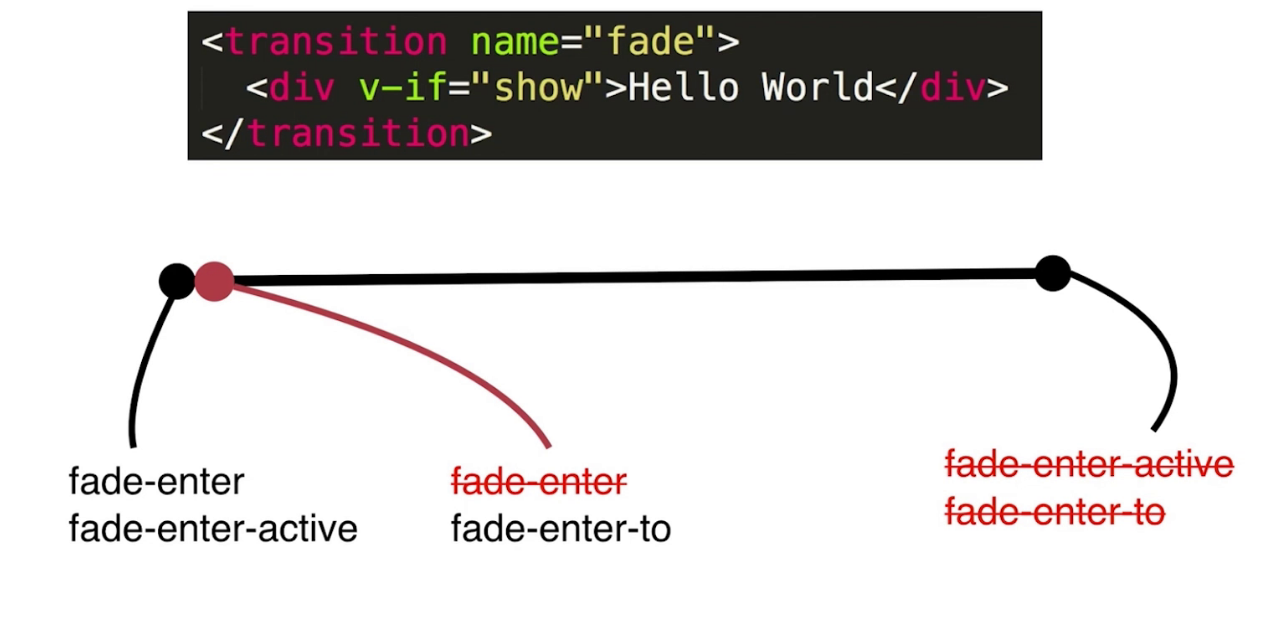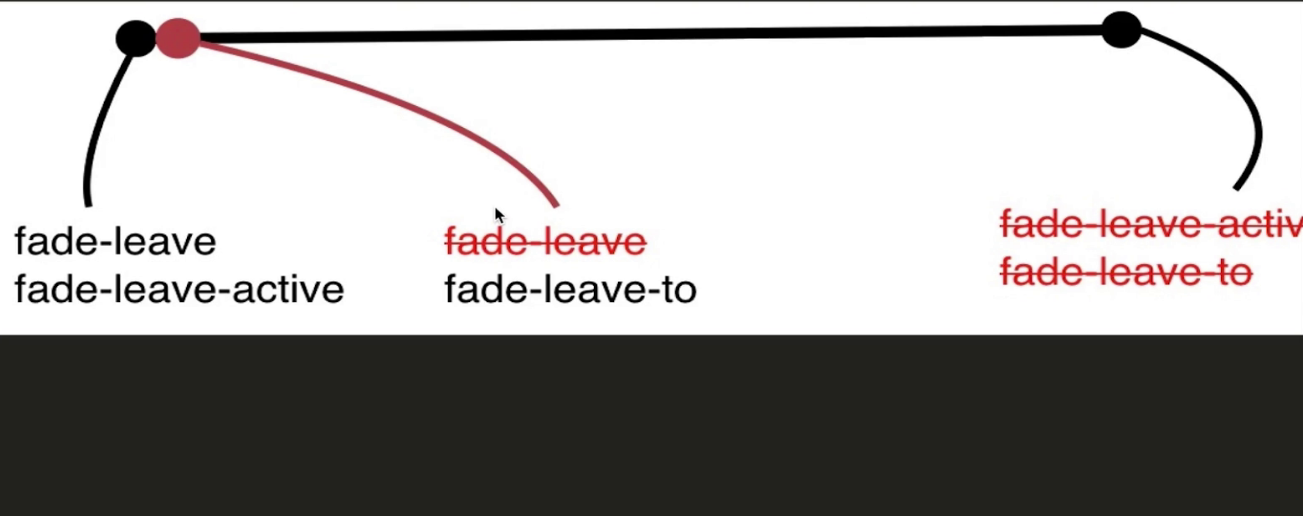1、vue 的动画流程分为enter,和leave分别对应以下两幅图


<!doctype html>
<html lang="en">
<head>
<meta charset="UTF-8"> <meta name="viewport" content="width=device-width, user-scalable=no, initial-scale=1.0, maximum-scale=1.0, minimum-scale=1.0"> <meta http-equiv="X-UA-Compatible" content="ie=edge"> <title>动画</title> <link rel="stylesheet" href="./lib/bootstrap.css"> <style> .yf-enter, .yf-leave-to { opacity: 0; } .yf-enter-active, .yf-leave-active { transition: opacity 2s; } </style> <script src="./lib/vue.js"></script> <script> window.onload = function () { let VM = new Vue({ el: '#outdiv', data: { content: 'this is test content', show: false }, methods: { change() { this.show = !this.show; } } }) } </script> </head> <body> <div class="container" id="outdiv"> <!--如果没有指定name那么默认为v-enter,v-enter-to,v-enter-active,v-leave,v-leave-to,v-leave-active--> <!--如果定义了name那么默认为name-enter,name-enter-to,name-enter-active,name-leave,name-leave-to,name-leave-active--> <!--当show为true的时候,即enter时opacity被赋值为0,随着动画的进行,yf-enter被删除掉那么opacity为1,同时定义的transition便起作用了--> <!--当show为false的时候,即leave时yf-leave的opacity为1,当动画进行时yf-leave-to的opacity为0,同时定义的transition便起作用了-->
<!--如果要定义顺序,那么可以添加mode='in-out'或者mode='out-in'这个通常在多个组件之间切换时运用-->
<transition name="yf"> <div class="jumbotron" v-if="show">{{content}}</div> </transition> <input type="button" value="切换" class="btn btn-primary" @click="change"> </div> </body> </html>
2、如果添加自定义动画,如引入animate.css动画
<!doctype html> <html lang="en"> <head> <meta charset="UTF-8"> <meta name="viewport" content="width=device-width, user-scalable=no, initial-scale=1.0, maximum-scale=1.0, minimum-scale=1.0"> <meta http-equiv="X-UA-Compatible" content="ie=edge"> <title>test</title> <link rel="stylesheet" href="./lib/bootstrap.css"> <link rel="stylesheet" href="./lib/animate.css"> <style> v-enter, v-leave-to { opacity: 0; } v-enter-active, v-leave-active { transition: opacity 3s; } </style> <script src="./lib/vue.js"></script> <script> window.onload = function () { let VM = new Vue({ el: '#outdiv', data: { content: 'this is a text', show: true }, methods: { change() { this.show = !this.show; } } }) } </script> </head> <body> <div class="container" id="outdiv"> <!--添加自定义的类,那么enter-active-class与leave-active-class可以赋值自定义的类名--> <!--如果需要指定刷新页面时的动画,那么需要指定两个类,appear与appear-active-class,用法同enter-active-class一样--> <!--因为animate.css是keyframe动画,那么需要添加过渡动画,那么就需要添加默认的(name|v)-active-class这个类---> <!--指定动画时长,如果以transition的动画时长为主,那么可以指定一个type值为transition毕竟animate.css的动画时长只有1s--> <!--如果需要定义一个明确的动画时长,可以添加属性:duration="{enter:5000,leave:3000}"注意以毫秒为单位,更简单的写法就指定一个值表示进入和离开的时间:duration="3000"--> <transition type="transition" appear appear-active-class="animated zoomInDown v-enter-active" enter-active-class="animated zoomInDown v-enter-active" leave-active-class="animated zoomOutUp v-leave-active"> <div class="jumbotron" v-if="show">{{content}}</div> </transition> <input type="button" value="点击" class="btn btn-primary" @click="change"> </div> </body> </html>
3、指定js的动画
通过transition这个标签的6个钩子函数执行动画before-enter,enter,after-enter,before-leave,leave,after-leave注意在每个enter或者leave的时候,会传入两个参数一个是执行动画的本体一个是函数,执行完动画后执行这个函数表示动画已经执行完毕,其余的只有一个函数表示动画执行的本体.
<!doctype html> <html lang="en"> <head> <meta charset="UTF-8"> <meta name="viewport" content="width=device-width, user-scalable=no, initial-scale=1.0, maximum-scale=1.0, minimum-scale=1.0"> <meta http-equiv="X-UA-Compatible" content="ie=edge"> <title>test</title> <link rel="stylesheet" href="./lib/bootstrap.css"> <link rel="stylesheet" href="./lib/animate.css"> <script src="./lib/vue.js"></script> <script src="./lib/jquery.js"></script> <script> window.onload = function () { let VM = new Vue({ el: '#outdiv', data: { show: true, content: 'this is test content' }, methods: { change() { this.show = !this.show; }, beforeEnter(elem) { $(elem).css('display', 'none'); }, handleEnter(elem, done) { $(elem).fadeIn(400, () => { done(); }); }, afterLeave(elem) { console.log('this is leave'); console.log(arguments); } } }) } </script> </head> <body> <div class="container" id="outdiv"> <transition @before-enter="beforeEnter" @enter="handleEnter" @after-leave="afterLeave" > <div class="jumbotron" v-if="show">{{content}}</div> </transition> <div class="form-group"> <div><input type="button" value="切换" class="btn btn-primary" @click="change"></div> </div> </div> </body> </html>
4、如果是多个组件,那么可以使用transition-group这个标签来处理
<!doctype html> <html lang="en"> <head> <meta charset="UTF-8"> <meta name="viewport" content="width=device-width, user-scalable=no, initial-scale=1.0, maximum-scale=1.0, minimum-scale=1.0"> <meta http-equiv="X-UA-Compatible" content="ie=edge"> <title>test</title> <link rel="stylesheet" href="./lib/bootstrap.css"> <link rel="stylesheet" href="./lib/animate.css"> <script src="./lib/vue.js"></script> <script> window.onload = function () { Vue.component('yf-test', { props: { list: { type: Array, required: false, default() { return [] } } }, template: '<ul class="list-group"><transition-group enter-active-class="animated zoomInUp"><li class="list-group-item" v-for="(value,index) of list" :key="index"><slot :data="value"></slot></li></transition-group></ul>' }); let VM = new Vue({ el: '#outdiv', data: { count: 1, list: [] }, methods: { add() { this.list.push(this.count++); } } }) } </script> </head> <body> <div class="container" id="outdiv"> <div class="jumbotron"> <div class="row"> <div class="col-md-6"> <yf-test :list="list"> <template slot-scope="props"> <div>{{props.data}}</div> </template> </yf-test> </div> <div class="col-md-6"> <yf-test :list="list"> <template slot-scope="props"> <b>{{props.data}}</b> </template> </yf-test> </div> </div> </div> <input type="button" value="增加" class="btn btn-primary" @click="add"> </div> </body> </html>
5、如果需要在vue项目是使用
import animated from 'animate.css' // npm install animate.css --save安装,在引入 Vue.use(animated)